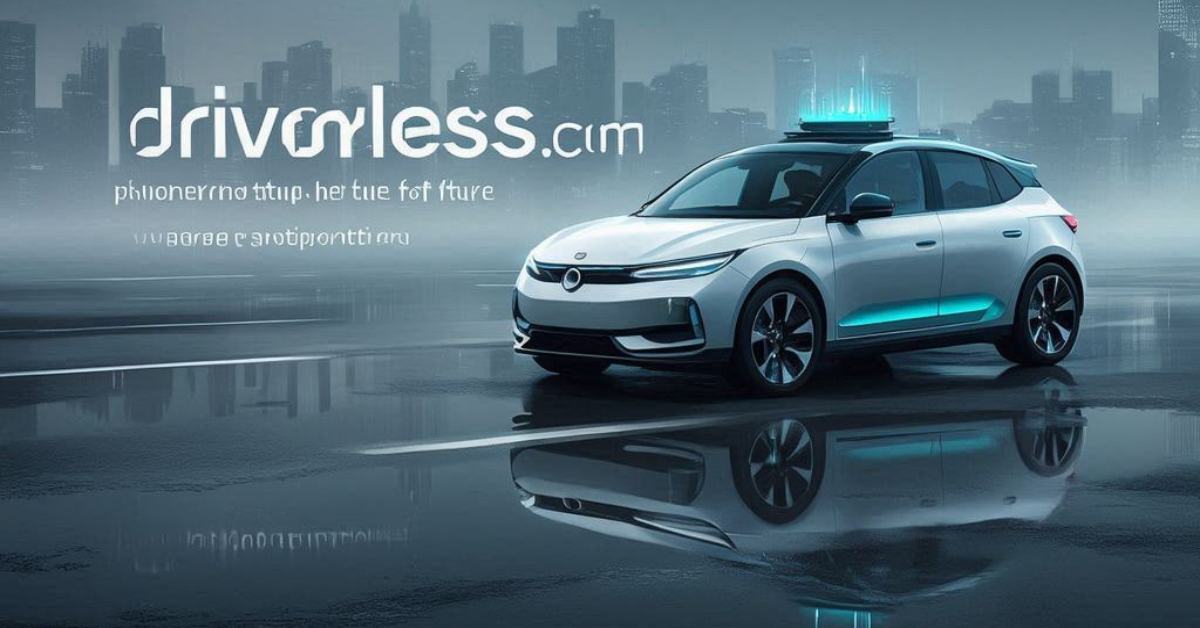Drivenless.com: Pioneering the Future of Transportation
In today’s rapidly evolving world, transportation is entering a new era defined by automation, sustainability, and cutting-edge technology. Drivenless.com stands at the forefront of this revolution, offering a comprehensive platform dedicated to exploring autonomous vehicles, electric mobility, and smart urban transportation solutions. This article provides a detailed guide on the innovations, challenges, and future of transportation as covered by Drivenless.com, delivering insights that cater to enthusiasts, industry professionals, and everyday readers alike.
Also Read: xiebutou-com/
What is Drivenless.com?
Drivenless.com is an online platform dedicated to providing in-depth coverage of modern transportation technologies. With a focus on autonomous vehicles, electric cars, and sustainable mobility, the platform aims to educate readers on the latest trends and developments in the field. Drivenless.com features articles, analyses, and guides that explain complex technologies in an accessible language, making it a valuable resource for anyone interested in the future of mobility. Key points about the platform are included:
- Comprehensive coverage of electric vehicles, autonomous driving, and hybrid technologies.
- Expert insights into smart city integration and sustainable urban mobility.
- Case studies and real-world examples for practical understanding
The Rise of Autonomous Vehicles
Autonomous Vehicles (AVs)
Autonomous vehicles (AVs) represent one of the most transformative advancements in transportation. Key highlights include:
- Levels of Autonomy: From Level 0 (no automation) to Level 5 (fully autonomous).
- Technologies Used: Sensor fusion, lidar, radar, and AI-powered decision-making.
- Safety Enhancements: How AVs reduce human error and improve road safety.
- Global Pilot Projects: Examples in cities like San Francisco, Phoenix, and Beijing demonstrating autonomous integration.
Electric Vehicles and Sustainability
Sustainability is a central theme in modern transportation. Electric vehicles (EVs) are crucial for reducing carbon emissions and promoting eco-friendly travel. Key points include:
- Battery Innovations: Advances in lithium-ion and solid-state batteries are improving range and efficiency.
- Charging Infrastructure: Public and private charging networks enabling convenient EV adoption.
- Government Incentives: Tax credits, rebates, and policies encouraging EV purchase.
- Environmental Benefits: Reduction of greenhouse gas emissions, cleaner air, and lower dependency on fossil fuels.
Urban Mobility and Smart Cities
As urban populations grow, efficient transportation becomes critical. Autonomous and electric vehicles integrate with smart city infrastructure to improve mobility. Key points include:
- Intelligent Traffic Management: AI-driven traffic lights and congestion control systems.
- Autonomous Public Transit: Driverless buses and shuttles are improving accessibility.
- Data Analytics: Using big data to optimize route planning and reduce travel time.
- EV-Friendly Cities: Infrastructure planning for charging stations, parking, and low-emission zones.
The Role of AI in Transportation
Artificial intelligence is a driving force behind modern mobility innovations. Key points include:
- Real-Time Decision Making: Vehicles reacting to changing traffic conditions instantly.
- Predictive Maintenance: AI monitoring vehicle health to prevent failures.
- Ethical Considerations: Algorithmic decisions in unavoidable accident scenarios.
- Machine Learning: AVs learning from experience to improve performance and safety.
Global Trends in Driverless Technology
Drivenless.com provides a global perspective on the adoption of autonomous vehicles. Key observations include:
- Regulatory Environment: Differences between the US, Europe, and Asia in AV laws.
- Infrastructure Readiness: How cities prepare roads, signage, and connectivity for AVs.
- Public Perception: Surveys showing varying levels of trust in driverless technology.
- Market Opportunities: Business and investment potential in AV technologies worldwide.
Challenges and Opportunities
The road to fully autonomous transportation is not without obstacles. Drivenless.com covers:
- Technical Challenges: Ensuring AV reliability in extreme weather and complex traffic conditions.
- Cybersecurity: Protecting AVs from hacking and data breaches.
- Insurance and Liability: How legal frameworks evolve with AV deployment.
- Workforce Adaptation: Reskilling drivers and technicians for AV and EV industries.
Opportunities include partnerships, innovative business models, and integrating AVs with renewable energy.
Future Innovations in Transportation
Drivenless.com looks ahead to technologies shaping the next decade of mobility. Notable innovations include:
- Vehicle-to-Everything (V2X): Vehicles communicating with infrastructure, other cars, and pedestrians
- 5G Integration: High-speed connectivity improves AV reaction times and data transmission.
- Blockchain in Transportation: Securing vehicle data and enabling transparent ride-sharing systems.
- Autonomous Fleet Management: Optimizing logistics, public transport, and ride-hailing services.
Sustainability Beyond Vehicles
Drivenless.com emphasizes a holistic approach to sustainable transportation:
- Multimodal Transport: Encouraging Cycling, Walking, and Public Transit
- Shared Mobility Services: Reducing congestion and resource use.
- Urban Planning Policies: Designing walkable, low-emission neighborhoods.
- Inclusivity: Making transportation accessible to all, including the elderly and disabled.
Why Drivenless.com Matters
Drivenless.com is a critical resource for anyone interested in the future of transportation. The platform provides:
- Expert insights into AV, EV, and AI technologies.
- Updates on policy, market trends, and technological breakthroughs.
- Real-world examples and case studies for practical understanding.
- Actionable knowledge for industry professionals, governments, and commuters.
Impact of Autonomous Vehicles on Road Safety
Autonomous vehicles have the potential to dramatically reduce traffic accidents caused by human error dramatically. Drivenless.com highlights how AVs utilize sensors, cameras, and AI to continuously monitor the environment, detect hazards, and make split-second decisions that humans might miss. The platform explores statistics from pilot projects showing lower accident rates in areas with autonomous vehicle testing. Additionally, it addresses how safety protocols, ethical decision-making algorithms, and real-time monitoring contribute to safer streets for pedestrians, cyclists, and drivers alike.
Also Read: aajkitajikhabar-com/
Economic Benefits of Driverless and Electric Mobility
The rise of autonomous and electric vehicles is not just a technological shift but also an economic opportunity. Key points include:
- Fuel Cost Reduction: AVs and EVs can significantly cut fuel expenses for individuals and businesses.
- Optimized Logistics: Autonomous systems improve delivery efficiency and route management for companies.
- Lower Insurance Premiums: Reduced accident frequency can lead to more affordable insurance.
- Job Creation: Emerging industries in EV manufacturing, software development, and AV maintenance generate new employment opportunities.
- Market Growth Insights: Case studies and market data reveal the financial advantages of adopting future mobility solutions.
Regulatory and Legal Frameworks for Autonomous Vehicles
For autonomous vehicles to succeed, legal and regulatory frameworks must evolve. Key considerations include:
- Safety Standards: Ensuring AVs operate safely under diverse conditions.
- Liability Issues: Determining responsibility in accidents involving autonomous vehicles.
- Data Privacy: Protecting user and operational data collected by AV systems.
- Traffic Laws: Adapting existing laws to accommodate driverless vehicles on public roads.
- Global Policy Trends: Governments in the US, Germany, and China are developing regulations to support AV testing while ensuring public safety.
Public Perception and Acceptance of Driverless Technology
The adoption of autonomous vehicles heavily depends on public trust. Key points include:
- Safety Concerns: Understanding how perceived risks influence consumer willingness to adopt AVs.
- Confidence in AI: Educating users about how AI makes real-time decisions in autonomous vehicles.
- Transparency in Testing: Providing open access to AV testing results to build trust
- Education Campaigns: Informing the public about benefits, safety measures, and technology.
- Hands-On Exposure: Allowing communities to experience autonomous vehicles firsthand to increase acceptance.
The Role of Big Data in Autonomous Transportation
Drivenless.com highlights how big data is transforming the transportation industry. Autonomous vehicles generate massive amounts of information from sensors, cameras, and GPS systems, which can be analyzed to improve traffic flow, optimize routes, and enhance safety. The platform explains how predictive analytics and data-driven insights help reduce congestion, anticipate vehicle maintenance needs, and enable smarter urban planning. By leveraging big data, AVs and smart cities can operate more efficiently, benefiting commuters and city planners alike.
Environmental Benefits Beyond Electric Vehicles
While EVs are essential for reducing emissions, Drivenless.com explores additional environmental strategies. These include integrating renewable energy sources for charging infrastructure, promoting shared mobility services to reduce vehicle numbers on the road, and designing pedestrian-friendly urban spaces. The platform also emphasizes hybrid technologies and alternative fuels as part of a holistic approach to sustainability. These measures collectively contribute to cleaner air, reduced carbon footprints, and greener cities.
Integration of Autonomous Vehicles with Public Transport
Complementing Public Transportation
Autonomous vehicles (AVs) can enhance existing public transit systems rather than replace them. Key points include:
- First- and Last-Mile Solutions: AV shuttles, buses, and rideshare vehicles bridge gaps in public transit networks.
- Efficiency Improvements: Integration with transit reduces wait times and optimizes route planning.
- Increased Public Transit Use: Seamless connections encourage more people to rely on public transportation.
- Traffic Reduction: Coordinated AVs help decrease congestion on busy roads.
- Environmental Benefits: Fewer vehicles on the road and smoother traffic flow reduce emissions.
Innovations in Vehicle-to-Everything (V2X) Communication
V2X communication enables AVs to interact with each other, traffic infrastructure, and pedestrians. Key points include:
- Enhanced Safety: Real-time alerts prevent accidents and improve situational awareness.
- Traffic Management: Coordinated communication optimizes signal timing and reduces congestion.
- Route Optimization: Vehicles receive updates about accidents, road conditions, or closures for efficient navigation.
- Research & Trials: Ongoing experiments demonstrate the effectiveness of connected vehicle networks.
- Smart Transportation Networks: V2X is a foundational technology for fully connected urban mobility systems.
Conclusion
Autonomous and connected vehicle technologies are transforming transportation. By complementing public transit, improving efficiency, and leveraging innovations like V2X, AVs contribute to safer, greener, and more accessible mobility solutions. These advancements are guiding the future of transportation toward a connected, sustainable, and intelligent urban environment.
Covering autonomous vehicles, electric mobility, AI integration, and urban planning, the platform equips readers with the knowledge needed to understand and engage with innovations transforming how we move. As cities become smarter and transportation systems more sustainable, Drivenless.com remains a leading resource, fostering awareness and promoting forward-thinking solutions in mobility. For more information and insights, visit.
Also Read:
- Ramitheicon 1.49m Subscribers: The Rise of a YouTube Sensation
- Aleksandra Plus: A Trailblazer Redefining Plus‑Size Modeling
- Illia Wayans: A Complete Guide to the Life, Career, and Rising Influence of Shawn Wayans’ Daughter
- Alissa Mahler: A Complete Biography, Career Insights, and Public Influence
- The Ultimate Guide to Jhonbaby777: Rise, Influence, and Digital Impact






